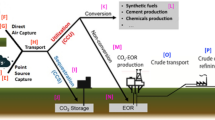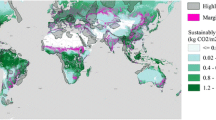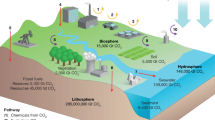Abstract
Atmospheric carbon dioxide (CO2) has increased from a preindustrial concentration of about 280 ppm to about 367 ppm at present. The increase has closely followed the increase in CO2 emissions from the use of fossil fuels. Global warming caused by increasing amounts of greenhouse gases in the atmosphere is the major environmental challenge for the 21st century. Reducing worldwide emissions of CO2 requires multiple mitigation pathways, including reductions in energy consumption, more efficient use of available energy, the application of renewable energy sources, and sequestration. Sequestration is a major tool for managing carbon emissions. In a majority of cases CO2 is viewed as waste to be disposed; however, with advanced technology, carbon sequestration can become a value-added proposition. There are a number of potential opportunities that render sequestration economically viable. In this study, we review these most economically promising opportunities and pathways of carbon sequestration, including reforestation, best agricultural production, housing and furniture, enhanced oil recovery, coalbed methane (CBM), and CO2 hydrates. Many of these terrestrial and geological sequestration opportunities are expected to provide a direct economic benefit over that obtained by merely reducing the atmospheric CO2 loading. Sequestration opportunities in 11 states of the Southeast and South Central United States are discussed. Among the most promising methods for the region include reforestation and CBM. The annual forest carbon sink in this region is estimated to be 76 Tg C/year, which would amount to an expenditure of $11.1–13.9 billion/year. Best management practices could enhance carbon sequestration by 53.9 Tg C/year, accounting for 9.3% of current total annual regional greenhouse gas emission in the next 20 years. Annual carbon storage in housing, furniture, and other wood products in 1998 was estimated to be 13.9 Tg C in the region. Other sequestration options, including the direct injection of CO2 in deep saline aquifers, mineralization, and biomineralization, are not expected to lead to direct economic gain. More detailed studies are needed for assessing the ultimate changes to the environment and the associated indirect cost savings for carbon sequestration.
Similar content being viewed by others
References
Allen LH Jr, Baker JT, Boote KJ (1996) The CO2 fertilization effect: higher carbohydrate production and retention as biomass and seed yield. In: Bazzaz F, Sombroek W (eds) Global climate change and agricultural production. Food and Agricultural Organization and Wiley, London
Arnott HJ (1974) Calcification in higher plants. In: Watabe N, Wilbur KM (eds) The mechanisms of mineralization in the invertebrates and plants. University of South Carolina Press, Columbia, SC
Barnes VE, Shock DA, Cunningham WA (1950) Utilization of Texas serpentine. The University of Texas, Bureau of Economic Geology, No. 5020
Beecy D, Kuuskraa V, Dipietro P (2001) Economic benefits of a national strategy and R&D program in carbon sequestration. In: Proceedings of first carbon sequestration, National Energy Technology Laboratory, Washington DC
Bergman PD, Winter EM (1995) Disposal of carbon dioxide in aquifers in the US. Energy Convers Manag 36:523–526
Bernacchi CJ, Hollinger SE, Meyers T (2005) The conversion of the corn/soybean ecosystems to no-till agriculture may result in a carbon sink. Glob Chang Biol 11:1867–1872
Braissant O, Cailleau G, Aragno M, Verrecchia EP (2004) Biologically induced mineralization in the tree Melicia excelsa (Moraceae): its causes and consequences to the environment. Geobiology 2:59–66
Bruant RG, Guswa AJ, Celia MA, Peters CA (2002) Safe storage of CO2 in deep saline aquifers. Environ Sci Technol 36:240A–245A
Bruce JP, Frome M, Haites E, Janzen HH, Lal R, Paustian K (1998) Carbon sequestration in soil. Soil Water Conservations Society White Paper
Bruce JP, Frome M, Haites E, Janzen HH, Lal R, Paustian K (1999) Carbon sequestration in soil. Soil Water Conserv Soc 54:382–389
Cailleau G, Braissant O, Verrecchia EP (2004) Biomineralization in plants as a long-term carbon sink. Naturwissenschaften 91:191–194
CCX (2004) About CCX. http://www.chicagoclimatex.com/about/
Cole CV, Duxbury J, Freney J, Heinemeyer O, Minami K, Mosier A, Paustian K, Rosenberg N, Sampson N, Sauerbeck D, Zhao Q (1997) Global estimates of potential mitigation of greenhouse gas emissions by agriculture. Nutr Cycl Agroecosyst 49:221–228
David J, Herzog H (2000) The cost of carbon capture. In: Proceedings of the Fifth International Conference on Greenhouse Gas Control Technologies, Cairns, Australia
Delcourt HR, Harris WF (1980) Carbon budget of the southeastern U.S. biota: analysis of historical change in trend from source to sink. Science 210:321–323
Denbury Resources (2005) Our tertiary oil fields. Plano, TX. http://www.denbury.com/W_Mississippi.htm
Ding T (2005) Gas hydrates to capture and sequester CO2. MS thesis, Department of Chemical Engineering, Mississippi State University. http://nt.library.msstate.edu/content/templates/?a=73
Edwards G, Walker DA (1983) C3, C4: mechanisms, and cellular and environmental regulation of photosynthesis. Blackwell, Oxford
ENCAP (2005) Enhanced capture of CO2. http://www.encapco2.org
EPRI (1999) Enhanced oil recovery scoping study. Electric Power Research Institute, Palo Alto, CA
FAO (1997) State of the world’s forests. Food and Agriculture Organization of the United Nations, Rome, Italy, pp 200
Fulton PF, Parente CA, Rogers BA, Shah N, Reznik AA (1980) A laboratory investigation of methane from coal by carbon dioxide injection. Soc Pet Eng J 65
Gunter WD, Gentiz T, Rottenfusser BA, Richardson RJH (1997) Deep coalbed methane in Alberta, Canada: a fuel resource with the potential of zero greenhouse gas emissions. Energy Convers Manag 38:S217–S222
Gunter WD, Wong S, Cheel DB, Sjostrom G (1998) Large CO2 sinks: their role in the mitigation of greenhouse gases from an international, national and provincial perspective. Appl Energy 61:209–227
Han FX, Plodinec MJ, Su Y, Monts DL (2005) Terrestrial carbon sequestration in Southeast and South-Central United States. In: Proceedings of the fourth annual conference on carbon capture and sequestration, National Energy Technology Laboratory, Alexandria, VA
Haq BU (1999) Natural gas deposits: methane in the deep blue sea. Science 285:543–544
He D, Edwards GE (1996) Estimation of diffusive resistance of bundle sheath cells to CO2 from modeling of C4 photosynthesis. Photosynth Res 49:195–208
Herzog HJ (2001) What future for carbon capture and sequestration? Environ Sci Technol 35:148A–153A
Hoffert MI, Caldeira K, Jain AK, Haites EF, Harvey LDD, Potter SD, Schlesinger ME, Schneider SH, Watts RG, Wigley TM, Wuebbles DJ (1998) Energy implications of future stabilization of atmospheric CO2 content. Nature 395:881–884
Holloway S (1997) An overview of the underground disposal of carbon dioxide. Energy Convers Manag 38(Suppl 1):S193–S198
ICF Resources Inc (1990) The United States coalbed methane resource: Quarterly Review of Methane from Coal Seams Technology 7(3): 10–28
IPCC (1996) Climate change 1995: Impacts, Adaptations and Mitigation of Climate Change. Cambridge University Press, Cambridge, UK
IPCC (2001a) Climate change 2001: mitigation. Cambridge University Press, Cambridge
IPCC (2001b) Climate Change 2001: The Scientific Basis. Cambridge University Press, Cambridge, UK
Johnsen KH, Wear D, Oren R, Teskey RO, Sanchez F, Will R, Butnor J, Markewitz D, Richter D, Rials T, Allen HL, Seiler J, Ellsworth D, Maier C, Katul GG, Dougherty PM (2001) Carbon sequestration and southern pine forests. J For 99:14–21
Katul GG, Oren R, Kasibhatla P, Ellsworth D, Lai CT, Schafer KVS, Ewers BE, Naumburg E (1999) Reassessment of carbon sequestration in forests of conterminous United States. In: American Geophysical Union Meeting, San Francisco, USA
Kempe S (1979) Carbon in the rock cycle. In: Bolin B, Degens ET, Kempe S (eds) The global carbon cycle. Wiley, Chichester, UK, pp 343–377
Kuhn M, Clauser C (2006) Mineral trapping of CO2 in geothermal used aquifers-reactive transport simulation on multiple scales. In: Birkholzer J, Tsang CF, Benson S, Karimjee A, Kobelski B (eds) Proceedings of the international symposium on site characterization for CO2 geological storage, Lawrence Berkeley National Laboratory, Berkeley, California
Kuuskraa VA, Koperma GJ (2006) Assessing and expanding CO2 storage capacity in depleted and near-depleted oil reservoirs. In: Birkholzer J, Tsang CF, Benson S, Karimjee A, Kobelski B (eds) Proceedings of the international symposium on site characterization for CO2 geological storage, Lawrence Berkeley National Laboratory, Berkeley, California
Kuuskraa VA, Boyer CM Jr, Kelafant JA (1992) Hunt for quality basins goes abroad. OGJ Special. Oil Gas J 5:49–54
Kvenvolden KA (1998) A primer on the geological occurrence of gas hydrate. In: Henriet JP, Mienert J (eds) Gas hydrates; relevance to world margin stability and climate change. Geol Soc 137:9–30 (special publication)
Lacuesta M, Dever LV, Muñoz-Rueda A, Lea PJ (1997) A study of photorespiratory ammonia in the C4 plant Amaranthus edulis, using mutants with altered photosynthetic capacities. Physiol Plant 99:447–455
Lal R, Kimble JM, Follett RF, Cole CV (1998) The potentials of US cropland to sequester carbon and mitigate the greenhouse effect. Ann Arbor, Chelsea, MI, pp 128
Lal R, Follett RF, Kimble JM, Cole CV (1999) Managing U.S. cropland to sequester carbon in soil. J Soil Water Conserv 54:374–381
Lewandrowski J, Peters M, Jones C, House R, Sperow M, Eve M, Paustian K (2004) Economics of sequestering carbon in the U.S. agricultural sector. USDA, Washington DC
Lindner JS, Wang C, Han FX, Plodinec MJ (2005) Final technical report on southeast regional carbon sequestration partnership. Southern State Energy Board. http://www.sseb.org/downloads/SECARBPIFinal.doc
Loaiciga HA, Valdes JB, Vogel R, Garvey J, Schwarz H (1996) Global warming and the hydrologic cycle. J Hydrol 174:83–127
Maroco JP, Ku MSB, Lea PJ, Dever LV, Leegood RC, Furbank RT, Edwards GE (1998) Oxygen requirement and inhibition of C4 photosynthesis, an analysis of C4 plants deficient in the C3 and C4 cycles. Plant Physiol 116(2):823–832
Mastalerz M, Gluskoter H, Rupp J (2004) Carbon dioxide and methane sorption in high volatile bituminous coals from Indiana, USA. Int J Coal Geol 60:43–55
O’Connor WK, Rush GE, Dahlin DC, Reidel SP, Johnson VG (2003) Geological sequestration of CO2 in the Columbia River Basalt Group. In: Proceedings of the 28th international technical conference on coal utilization and fuel systems. Coal Technology Association, Clearwater, FL
O’Connor WK, Dahlin DC, Rush GE, Gerdemann SJ, Penner LR, Nilsen DN (2005) Aqueous mineral carbonation: mineral availability, pretreatment, reaction parametrics, and process studies (final report submitted to Office of Fossil Energy, US Department of Energy). Albany Research Center, New York
Pashin JC (2004) Enhanced coalbed methane recovery and CO2 sequestration. In: Proceedings of applied technology workshop, Denver, CO
Pashin JC, Groshong RH Jr, Carroll RE (2001) Enhanced coalbed methane recovery through sequestration of carbon dioxide: Potential for a market-based environmental solution in the black Warrior Basin of Alabama. In: Proceedings of the first national conference on carbon sequestration, National Energy Technology Laboratory, Washington D.C
Paustian K, Collins HP, Paul EA (1997) Management controls on soil carbon. In: Paul EA, Elliott ET, Paustian K, Cole CV (eds) Soil organic matter in temperate agroecosystems: long-term experiments in North America. CRC Press, Boca Raton, FL, pp 15–49
Ramanathan V (1988) The greenhouse theory of climate change: a test by an inadvertent global experiment. Science 240:293–299
Reznik AA, Singh PK, Foley WL (1984) An analysis of the effect of CO2 injection on the recovery of in-situ methane from bituminous coal: an experimental simulation. Soc Pet Eng J :521–528 (Oct)
Richards KR, Moulton R, Birdsey R (1993) Costs of creating carbon sinks in the U.S. Energy Conservs Manag 34:905–912
Robertson GP, Paul EA, Harwood RR (2000) Greenhouse gases in intensive agriculture: contributions of individual gases to the radiative forcing of the atmosphere. Science 289:1922–1925
Roskill (1990) The economics of olivine 1990, 2nd edn. Roskill Information Services, London, England
Ross HE, Zoback MD (2006) Geomechanically constrained simulation of CO2 sequestration and enhanced methane recovery in coalbeds of the Powder River Basin, Wyoming. In: Birkholzer J, Tsang CF, Benson S, Karimjee A, Kobelski B (eds) Proceedings of the international symposium on site characterization for CO2 geological storage, Lawrence Berkeley National Laboratory, Berkeley, California
Sampson RN, Apps M, Brown S, Cole CV, Downing J, Heath LS, Ojima DS, Smith TM, Solomon AM, Wisniewski J (1993) Workshop summary statement—terrestrial biospheric carbon fluxes—quantification of sinks and sources of CO2. Water Air Soil Pollut 70:3–15
Sengbusch Pv (2003) Botany online—the internet hypertextbook. http://www.rrz.uni-hamburg.de/biologie/b_online/
Skog KE, Nicholson GA (1998) Carbon cycling through wood products: the role of wood and paper products in carbon sequestration. For Prod J 48:75–83
Smith DH, Seshadri K, Wilder JW (2001) Assessing the thermodynamics feasibility of the conversion of methane hydrate into carbon dioxide hydrate in porous media. J Energy Environ Res USDOE 1:101–116
Sohei S, Li H, Oshima Y, Adachi (2006) Displacement behavior of CH4 adsorbed on coals by injecting pure CO2, N2, and CO2–N2 mixture. Environ Geol (Heidelberg, Germany) 49:44–52
Sombroek WG, Gommes R (1996) The climate change—agriculture conundrum. In: Bazzaz F, Sombroek W (eds) Global climate change and agricultural production. Food and Agricultural Organization and Wiley, London
Stavins RN, Richards KR (2005) The cost of U.S. forest-based carbons sequestration. Pew Center on Global Climate Change, Arlington, VA
Stefan A (2004) Environmental impact of geothermal energy utilization. Geol Soc Spec Publ 236:297–336
Stevens SH, Kuuskraa VA, Spector D, Riemer P (1999a) Sequestration in deep coal seams: pilot results and worldwide potential. In: Baldur E, Pierce R, Alexander W (eds) Proceedings of the 4th international conference on greenhouse gas control technologies, Interlaken, Switzerland, Elsevier, Oxford, UK, pp 175–180
Stevens SH, Schoeling L, Pekot L (1999b) CO2 injection for enhanced coalbed methane recovery: project screening and design. In: Pashin JC (ed) The proceedings of the 1999 international coalbed methane symposium, Tuscaloosa, Alabama, pp 309–317
Thiez PL, Mosditchian G, Torp T, Feron P, Ritsema I, Zweigel P, Lindeberg E (2004) An innovative European integrated project: CASTOR–CO2 from capture to storage. http://www.co2castor.com
US Department of Energy (1999) Carbon sequestration, state of the science. US Department of Energy, Office of Energy, Office of Fossil Energy, Washington, DC
USDA National Agricultural Statistics Service (2003) Agricultural statistics. US Government Printing Office, Washington DC
USDOE (2004) CO2 EOR technology. USDOE National Energy Technology Laboratory, USA
Venterea RT, Burger M, Spokas KA (2005) Nitrogen oxide and methane emissions under varying tillage and fertilizer management. J Environ Qual 34:1467–1477
Viete DR, Ranjith PG (2006) The effect of CO2 on the geomechanical and permeability behavior of brown coal: implications for coal seam CO2 sequestration. Int J Coal Geol 66:204–216
Walther GR, Post E, Convey P, Menzel A, Parmesan C, Beebee TJC, Jean-Marc Fromentin JM, Hoegh-Guldberg O, Bairlein F (2002) Ecological responses to recent climate change. Nature 416:389–395
White CM, Strazisar BR, Granite EJ, Hoffman JS, Pennline HW (2003) Separation and capture of CO2 from large stationary sources and sequestration in geological formations—coalbeds and deep saline aquifers. J Air Waste Manag Assoc 53:645–715
Winjum JK, Brown S, Schlamadinger B (1998) Forest harvests and wood products: sources and sinks of atmospheric carbon dioxide. For Sci 44(2):272–284
Acknowledgements
This work is supported by the United States Department of Energy (DOE) Southeast Regional Carbon Sequestration Partnership program, DOE carbon sequestration grant number SSEB-NT41980-997.
Author information
Authors and Affiliations
Corresponding author
Rights and permissions
About this article
Cite this article
Han, F.X., Lindner, J.S. & Wang, C. Making carbon sequestration a paying proposition. Naturwissenschaften 94, 170–182 (2007). https://doi.org/10.1007/s00114-006-0170-6
Received:
Revised:
Accepted:
Published:
Issue Date:
DOI: https://doi.org/10.1007/s00114-006-0170-6




